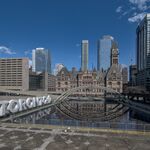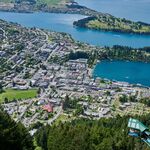I think I would argue for a single stop called Bathurst-Vaughan.
I would argue for a full platform for the entire block between those 2 streets, which, as can be seen in the photo below is ~107M
View attachment 418580
For reference, in the photo below, the standard platform length on St. Clair is ~35M before the landscaping kicks in and the platform narrows out; long enough for one Flexity.
Here, I would propose a platform that can hold 2 Flexities (3 in theory); but I would not set it up for that, with it made clear where the lead position is for loading/offloading. (set 15M in from the facing direction)
This choice is feasible; however, IF one keeps St. Clair at 2 travel lanes in each direction, for cars, it would require removing the lefthand turn lane from EB St. Clair to NB Bathurst.
I dislike this solution.
My preference would be to remove extra travel lane in this block, as I don't view it as necessary, the left-hand turn lane can then be retained; the surplus space can be used for any/all of wider sidewalks,
cycle tracks, cycle tracks with landscaped buffer, wider streetcar platforms with landscaped buffer.
I reviewed every streetview image for this block going back to 2007 to support my anecdotal opinion that the curb lane is surplus and I can confirm not one of them shows heavy traffic in this block.
There are parts of St. Clair where removing a travel lane might be more controversial, especially if that also meant removing parking; but in this block, I don't believe that applies.




